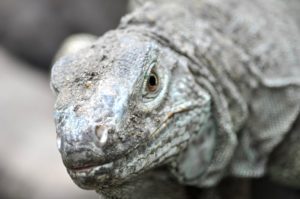Welcome to this article about Komodo dragons! The Komodo dragon happens to be one of the largest and heaviest lizards in the world and one of the only venomous lizard species. They are powerful hunters with an acute sense of smell and have the potential to bring down a large cow as its prey. Join us as we discover facts about this impressive animal!

Physical and Scientific Characteristics
- The Komodo dragon’s scientific name is Varanus komodoensis.
- Komodo dragons can grow up to 3m in total length and will usually weigh around from 70-90kg depending on the sex.
- Their tail happens to be as long as its body, which accounts for about half of its full body length.
- The jaw is comprised of around 60 serrated and defined teeth that usually grow up to 1 inch. This is especially helpful for tearing apart chunks of meat that it consumes.
- The Komodo dragon also has a prominent, long and forked tongue which is a sharp sensory organ used to detect taste as well as smell. This enables it to detect prey or carrion that is up to 9.5km away.
- The skin of the Komodo dragon is strengthened by armored scales connected by tiny bones (known as osteoderms).
- When considering their hearing, their ear arrangement allows them to hear sounds at a restricted range of 400 to 2000Hz. They also have poor night vision.
- Identifying the sex of the Komodo dragon is quite difficult as there are no obvious morphological variations between the males and females.
Komodo Dragons Habitat and Distribution
- This species of lizard is exclusive to the Indonesian islands of Komodo, Flores, Padar, Rinca and smaller islands in the region.
- They prefer hot and dry habitats which typically include open grasslands, savanna and tropical forests.
- They dig burrows in order to sleep and preserve energy and heat during the night. During resting periods, they have been observed to lie around areas near water pools in order to cool down.
Komodo Dragons Behavior
- Komodo dragons are primarily carnivores and are the apex predators of the area as there are no other carnivores living in the islands.
- The fact that they are the sole predators is a reason as to why they have a large size, which is also known as island gigantism.
- They mostly consume carrion (dead animal carcasses) but are active predators who can easily ambush prey.
- Komodo dragons are ectotherms (dependant on external heat sources) and are mostly active during the day as opposed to the night.
- They are capable of running at speeds of up to 20 km/h in order to ambush or pursue prey.
- The largest male animal usually displays dominance and males have been shown to engage in ‘wrestling’ battles in order to establish this hierarchy.
- Drinking of water is usually carried out by a process known as buccal pumping, where the animal will take water into its mouth, lift its head and allow the water to run down to the stomach.
- The mating period is between May and August while the females lay their eggs in September. These animals tend to have an aggressive courtship before mating occurs.
- Komodo dragons are one of the few lizard species in the world to show monogamy where they form pair bonds with their counterparts.
- Young Komodo dragons are vulnerable to being eaten by other predators (including other adult Komodo dragons) and therefore spend most of their time in trees. In order to avoid being eaten by the adults, they roll around in feces and droppings to avoid detection by smell. They will mature after 9 years.
- Komodo dragons have a life expectancy of around 30 years.
Komodo Dragons Diet and Predation
- Typically, when attacking, they will go for the throat region to disable the prey and can use their thick tails as a weapon too. The bite of a Komodo dragon is venomous which can easily cause a fatal injury to the animal.
- The chief source of prey will be Timor deer although they attack a wide range of other prey such as water buffaloes, wild boars, large pigs, goats, birds, and monkeys.
- The muscles in the jaw enable it to tear large chunks of meat and swallow them rapidly. It can consume up to 80% of its own body weight before finishing its meal.
- In order to speed up the process, the Komodo dragon may even ram the prey into a tree to force the meat down its throat.
- After eating, it rests under sunlight to speed digestion. This will prevent the carcass from rotting which could infect the Komodo dragon.
- Due to their large consumption habits, they can survive on as little as 12 meals for an entire year!
- There is a hierarchy when it comes to feeding. Usually, the adults and larger specimens eat first before the younger juveniles start to feast.
I hope that these facts about Komodo Dragons were helpful! If you want to see more information about animals, visit animal facts page!
